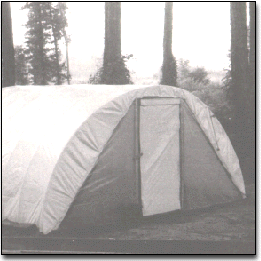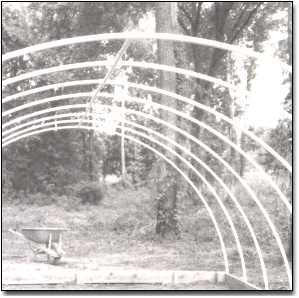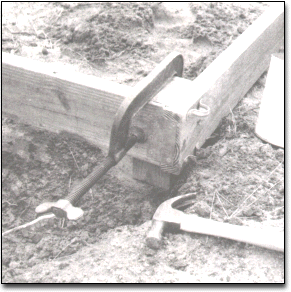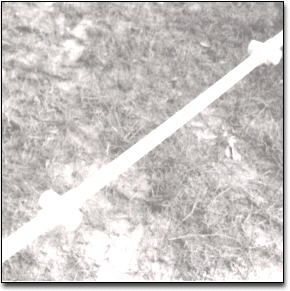A Small Backyard Greenhouse
For the Home Gardener
A greenhouse can be built easily and inexpensively in several hours
using simple hand tools and materials available at most building supply
stores. This publication presents plans and instructions for an easily
constructed greenhouse that costs about $100 and may be used for many purposes.
Measuring 12 feet by 14 feet (168 square feet), it is small enough to be
unobtrusive but large enough to meet the needs of the serious grower. The
completed structure is shown in Figure 1.
Selecting a Site
Choose a level, well drained plot for the greenhouse. If it will be
used primarily for plant propagation in the summer, place it in partial
shade to minimize heat buildup. A good location is the north side of a
large tree. If a partially shaded site is not available, you can use a
shade cloth or a white plastic cover to control the amount of sunlight
reaching the interior.
If the greenhouse will be used for starting transplants or growing plants
to maturity, it will need maximum exposure to the sun. It should also be
located where air drainage is good; avoid low areas surrounded by woods
or buildings. Easy access to running water and electricity is also important.

Figure 1. A backyard greenhouse constructed from inexpensive materials.
Constructing the Greenhouse
The greenhouse consists of a wooden frame to which are attached bows
of polyvinyl chloride (PVC) pipe. The bows hold up the clear plastic film
covering, as shown in Figures 1 through 3.

Figure 2. Bows of PVC pipe are used to hold up the plastic film covering.
All lumber for construction should be treated for ground contact with
an environmentally safe preservative such as CCA. Avoid wood preserved
with chemicals such as pentachlorophenol or creosote. Lumber treated for
ground contact has a higher concentration of preservative and therefore
will last much longer than untreated or lightly treated wood. Except for
the covering, the structure should last 10 to 12 years.
Unless the site is very flat, you will need to level the foundation
boards. This is best done by digging a trench on the high side instead
of raising the low side, as the foundation boards should contact the ground
at all points to ensure a good seal. To keep rainwater out, however, the
top of the foundation board should not be below ground level, particularly
around the door. the purpose of the 4-inch-by-4-inch post at each corner
(Figure 4) is to anchor the greenhouse and prevent it from moving in high
winds.
The PVC pipe bows are attached to the side boards of the foundation
with electric metallic tubing (EMT) clamps (Figure 4). It is best to attach
the clamps loosely to the side boards with wood screws before you secure
the side boards to the end boards and corner blocks. They may be tightened
after the PVC pipe has been slipped into place.
PVC pipe may be purchased in 12- or 20 foot lengths in either schedule
40 or schedule 80 weights. Schedule 80 PVC pipe has a thicker wall and
is stronger than schedule 40 pipe. It is therefore recommended for greenhouse
construction. The 12 foot width of the greenhouse was chosen so that each
half of the rib section of pipe is 10 feet long. PVC pipe may be easily
cut with a hand say, although a neater cut can be made with a pipe cutting
tool specially designed for that purpose. Care must be taken during assembly
because the cement used to fasten PVC is fast acting and permanent. It
should not be used when the temperature is below 50 degree Farenheight.
Check the directions on the can.
It is best to lay all parts out on a flat surface for assembly. For
the ribs to be 2 feet apart, the mid-rib pipe must be cut into pieces about
22 1/2 inches long (Figures 3 and 5). After all joints have been cemented
and allowed to harden for a few minutes, position the entire assembly over
the foundation boards, bend the ribs, and secure them in place with the
EMT clamps. Assembly is best done by two or more people to prevent over
stressing the cemented joints. Ten feet of galvanized EMT positioned inside
the mid-rib will give added strength to the structure.
Figure 3. Construction Details
(See also Bill of Materials )
After all the PVC ribs have been secured, the end frames and door may
be constructed. Although there is a door on only one end, both frames are
essentially the same. The two diagonals on each end give strength to the
structure and make it easy to secure the cover. The top of the end frame
may be fastened to the end ribs with either a wood screw of a small metal
strip bent into a U shape. If wood screw are used, the PVC pipe must be
predrilled to prevent splitting.
Select the type of cover material according the intended use of the
greenhouse. Clear 4- or 6 mil plastic greenhouse film is generally best
if the house will be used for growing plants. If it will be used exclusively
for propagating or over wintering plants, consider using 4- or 6 mil milky
or white copolymer film. White copolymer film reduces the amount of heat
and light within the house and therefore limits the fluctuations in these
factors, keeping conditions more nearly constant during propagation or
over the winter. However, shading clear plastic with a 30 to 50 percent
polypropylene shade cloth or greenhouse whitewash available from horticultural
supply companies will produce nearly the same effect.

Figure4. Foundation side and end boards are attached to 4-by-4 posts
to anchor the
structure. Note the EMT clamps on the side boards hold the PVC pipe
ribs.
The cover may be attached with small tacks, but staples are much faster
and are more secure. Allow the cover to extend several inches past the
bottom of the foundation boards and cover the extra material with packed
soil to prevent the entrance of moles and rainwater. An inch of coarse
sand or fine gravel on the floor will reduce problems with mud and weeds.

Figure 5. The mid-rib pipe is cut into sections about 22 1/2 inches
long and rejoined with
PVC crosses to which the ribs are attached. Ten feet of EMT is placed
inside the mid-rib for
strength.
Operating the green house
It is essential that the house be as tight as possible so that it retain
both heat and humidity. Problems with overheating can usually be solved
by simply opening the door. Supplemental heat can be provided if needed
during very cold weather or at night by one or more heat lamps or a small
electric heater. Any electrical devices used in the damp environment of
a greenhouse should be connected only to a circuit equipped with an approved
ground fault current interrupter (GFCI) outlet or circuit breaker. Other
source of heat can be used, but even very small gas or oil heaters will
usually overheat a greenhouse this small and may not burn well if not properly
ventilated.
The greenhouse will satisfactorily support up to 4 inches of dry snow.
If the snow is deeper or unusually wet, one or more temporary supports
should be provided along the mid-rib to prevent collapse. If a larger greenhouse
is required, the length may be increased. Do not increase the width of
the house without increasing the size of the ribs. Doing so will seriously
reduce the ability of the house to withstand snow and wind loads.
Advanced Information
Heating
Gas heaters, wood furnaces or wood fired hot water heaters are probably
most practical for greenhouse vegetable operations. Smoke and fumes from
heating are toxic to plants; therefore, flues must be tight. The heat should
be thermostatically controlled. Size of heating unit required may be calculated
by using this formula:
-
(Square feet of exposed surface) x (1.2 for single layer of plastic) or
(.8 for double layer of plastic) x (minimum required inside temperature
minus minimum expected outside temperature) = BTU's required.
Example: Your house has 4,000 square feet of exposed surface, you have
a single layer of polyethylene, your minimum required house temperature
is 58 F and you expect the outside temperature to get as low as 10 F. The
calculation would be 4,000 x 1.2 x 48 (58 minus 10) = 230,400 BTU's required.
If the wind velocity averages over 15 miles per hour during the heating
season, the heat requirement should be increased by 4% for each 5 mph above
15 mph.
Since heat rises, a circulating or turbulating fan, operating continuously,
will stir the air, which will help maintain a more uniform temperature
throughout the house, and will reduce condensation and reduce your heat
bill. A polyethylene tube near the top of the house is most often used
for this purpose.
Ventilation
Ventilation is necessary to control temperature, control humidity, and
replenish carbon dioxide needed by the plants. Without ventilation, temperatures
can build up to above 100 F when outside temperatures are much lower. Temperatures
above 90 F are detrimental to fruit set and plant growth. Most growers
use thermostatically controlled fans with enough capacity to change the
air in the house in one minute. High humidity results in condensation,
greater disease problems, and less light. Even on cold days and at night
ventilation is necessary to exhaust "wet air" and bring in "dry air" and
carbon dioxide. Ventilators should be located high enough so that the cold
air comes in above the growing plants. Many growers are using poly-ethylene
tubes for ventilation. These tubes extend the entire length of the house,
are about 3 feet in diameter, held up by wire and have 3 inch holes every
3-5 feet on both sides of the tube. One end of the tube may be connected
around the ventilating fan; the other end to louvered shutters. This allows
fresh air to be brought in gradually without chilling the plants and exhausts
the warmest air which is near the top of the house. The temperature to
maintain in your house will depend on the outside weather -- primarily
sunlight. The following temperatures are considered ideal:
Sunny Weather
Day--70 -80 F
Night--58 F-60 F |
Cloudy Weather
Day--65 F-75 F
Night--57 F-58 |
Night temperatures below those indicated could result in poor fruit
set. Higher temperatures often result in rapid vegetative growth, spindly
plants, poor fruit set, and lower yields. |
Uses
A small greenhouse can be quite useful throughout the year for many
different purposes. In the early spring, it can be used germinated and
grow bedding and vegetable plants earlier that would otherwise be possible.
In the summer it can be used either with or with out a mist system of humidifier
as a propagation house to root cutting. It can be used in the fall to start
winter vegetable plants. During the winter, it can protect patio plants
and other hardy but containerized woody plants. |



